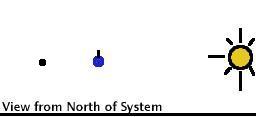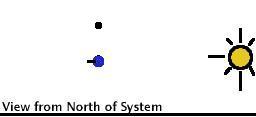Phases of the Moon
Summary
This lab is designed to be an introduction to the scientific process. You will,
using simple tools, deduce the motion of the Moon around the Earth. You will
determine the direction of motion, and the reason for the phases.

Procedure
- Form a group of three with your neighbors. Choose one person to be the Moon, one person to be the Earth and one person to be the Record-keeper.
- Study the phases chart above, which shows the moon at different phases throughout the lunar cycle. Note carefully what changes about the moon from each image to the next.
- The Moon should pick up a styrofoam ball from the front of the room, and then everyone heads out to the hallway.
- Choose a location for the Sun. The Sun remains stationary for the entire lesson after that! (It's often easiest to say that the 'Sun' is located at one end of the hallway.)
- The Earth stands in one spot for the entire lesson (but can turn around to see the Moon). The Moon stands relative to the Earth so that the styrofoam ball appears to the Earth in each phase. The Moon must make sure that the white side of the styrofoam ball always faces towards the 'Sun'! The Earth decides when the appropriate phase is shown.
- The images below are all looking down on the Earth-Moon-Sun system from North. All should try to imagine what a spaceman, looking down from North, would see for each phase. The recorder marks the location of the Moon in the appropriate box in the table below.
 |  |  |  |
| Waning Crescent | New | Waxing Crescent | First 1/4 |
 |  |  |  |
| Waxing Gibbous | Full | Waning Gibbous | Third 1/4 |
When you are finished, work together to answer the following questions:
1. In which direction does the Moon orbit the Earth? CLOCKWISE or COUNTERCLOCKWISE
2. For observers from the Northern hemisphere, which side of the Moon is illuminated when the Moon is just past new phase? RIGHT or LEFT
3. If you were to observe a crescent moon with the horns of the crescent pointing right, is the Moon WAXING or WANING? Hint: consider the previous question!
4. When an earth-bound person observes the Moon in its full phase, which phase of Earth is observed by a person on the Moon? NEW or FULL or SOME OTHER PHASE
5. In the following three pictures, fill in the missing piece (either in the top or the bottom panel).
6. Mars has two moons, Phobos and Deimos. In the picture,

- What is the phase of Phobos as seen from Mars?
- What is the phase of Deimos as seen from Mars?
- What is the phase of Deimos as seen from Phobos?
7. For each of the following pictures, what is the time for the observer (the solid black line), what phase is the Moon in, and where is it in the observer's sky?
 |  |
| Time: | Time: |
| Phase: | Phase: |
| Location: | Location: |






















